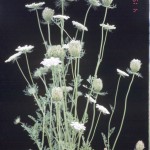Bishop's Weed, False Queen Anne's Lace, Large Bullwort, Greater Ammi
Ammi majus L.
Apiaceae
Description
Bishop's Weed is a showy, cool season annual reaching up to 3 feet or 0.9 m tall. The oblong leaves may be up to 8 inches long and 5.5 inches wide. The leaves are compound, toothed, pointed at the tip, and rounded at the base. The many white flowers are arrayed in an umbrella shape up to 3 inches or 7.6 cm across located at branch tips. Each flower gives rise to a small, oblong, rough fruit.Habitat
This plant was introduced from the Mediterranean region and has been widely disseminated in the Western Hemisphere. It is found in East and South Texas, usually along roadsides, as it has apparently been included in some wildflower seed mixes. In the past 15 years, Bishop's Weed has become more widespread and is now established in some roadside pastures. It will likely spread further in the coming years, posing a more significant threat to livestock.Toxic Agent
Bishop's Weed contains a furocoumarin in all parts of the plant, but it is especially concentrated in the seed. The compound is photoactive, causing primary photosensitization in cattle, sheep, horses, pets, and birds. All animals consuming the seed should be considered at risk.Signs of Livestock Ingestion
Signs in affected animals: increased body temperature; Photophobia (the animals shy away from light); Edema of the muzzle, ears, udder, scrotum, and vulva; Sunburn of light-colored skin; Inflammation of the skin. Thin-skinned areas and those having thin or no hair are often those most affected. Inflammation is followed by swelling, blisters, fluid seepage and sometimes sloughing of the skin. In dark-colored animals, the skin is not blistered or sloughed but may become painful and thickened, with crusted hair.Management Strategies
Primary photosensitization does not usually result in death. Some animals become severely scarred, and the growth of young calves can be stunted because the cows will not let them nurse. Provide adequate water and feed in the shade to prevent further sunburn. Check pastures next to roads with Bishop's Weed for flowering plants, which should be removed before seeds form.Images
Plant Characteristics
Flower Color: White
Seed Type: Fruit/Berry
Duration: Annual
Stem Texture: Hairless/Smooth
Growth Habit: Forbs/Broadleaf
Leaf Shape
 : Pinnately Compound
: Pinnately Compound
Season: Cool
Distribution
 : 01 - Pineywoods, 02 - Gulf Prairies and Marshes, 03 - Post Oak Savannah, 04 - Blackland Prairies, 05 - Cross Timbers and Prairies, 06 - South Texas Plains, 07 - Edwards Plateau
: 01 - Pineywoods, 02 - Gulf Prairies and Marshes, 03 - Post Oak Savannah, 04 - Blackland Prairies, 05 - Cross Timbers and Prairies, 06 - South Texas Plains, 07 - Edwards Plateau
Distributions
Distribution refers to the ecological region in Texas that a plant has been found. You can also view a clickable map.
Book: Toxic Plants of Texas (B-6105)
Collection: Toxics, Wild Flowers
Livestock Affected: Cattle, Goats, Horses, Sheep
Livestock Signs: Photosensitization




